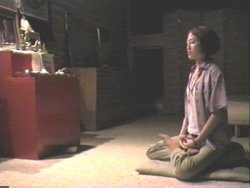
|
 |
Seven Point Meditation Posture
|
1. Legs. Although preferable, it is not necessary to
sit on a cushion in the full vajra or lotus position, as shown in this photograph. You may
sit in the half lotus or a cross legged position. If this is not comfortable, you may sit
in a straight back chair with your feet flat on the floor.
2. Arms. Your shoulders and arms should be relaxed. Your arms should not be pressed
against your side, but just far enough from your body to allow the circulation of air.
Place your hands in your lap with the right hand being cradled by the left and the tips of
your thumbs touching at a point about level with your navel.
3. Back. Sit with your back straight, as though you were being held erect by a string
running through your spine to the ceiling. This is the most important feature of
meditative posture because slouching will cause fatigue and drowsiness.
4. Eyes. Your eyes should be slightly open in an unfocused gaze to prevent dozing and
distraction. If keeping your eyes open seems to induce distraction, then close them until
your mind becomes calm. This point has not been consistent among teachers. Some meditation
masters do recommend keeping the eyes closed.
5. Jaws. Relax your jaws with your teeth slightly apart, not clenched.
6. Tongue. Touch your tongue to the roof of your mouth, just behind your front teeth. This
will lessen the accumulation of saliva and the need to swallow.
7. Head. Lower your head slightly so that your gaze is cast three to five feet out on the
floor to the front.
(Most of this advice was taken from Kathleen
McDonald's book How to Meditate, A Practical Guide.)
|

